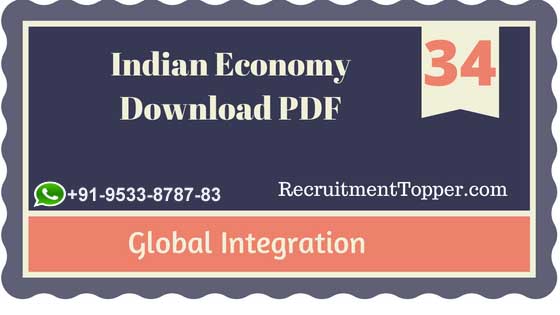Indian Economy | Global Integration Download PDF
Contents
Global Village
While discussing the concept of globalization we had discussed the rapid global integration being driven by a number of factors, especially in the last two decades. We had talked of the seamless emergence of a ‘global village’ and transition of the global economy from first polarized, and then multi-polarized to the present inter-dependence not bound by nationalities.
The growing inter-dependence amongst economies has a very important role to play in achieving the global integration. It is not the size of economies but interdependence which makes the integration a necessity. It is the shrinking of the global economy from an economic perspective. Goods and services of countries, increasingly becoming global, companies going global with multiple locations, multiple markets, not identifiable by countries of origin.
Integration is also about colour of money or their origin losing significance and driven by opportunities and markets rather than by countries. We had also discussed previously about some ‘key facilitators’ of this integration in the section on Globalization. Very often both these terms are seen as meaning the same, but actually globalization is the ‘result’ of integration.
Yet another underlying factor facilitating the economic integration process is the silent financial sector integration across boundaries. This has been aided by leaping technology making it possible to do electronic trans-national transactions seamlessly, in the fastest possible manner.
Sitting on a computer, transactions could be performed anywhere in the world without any physical movements. The global financial sector was reaching new frontiers of technology, services, convenience, diversified products and at the same time continued to expand and spread across geographies. Both the financial sector as well as the economic integration achieved over the last two decades had its own share of hiccups in the form of crisis in different countries.
The crisis in Mexico, Chile, SE Asian economies, Argentina, etc., in the earlier decades, did slow down the integration process, but has survived so far. The era of post-90s has seen increasing global deregulation of trade, capital inflows and financial regulations which has made this integration faster. It has also resulted in ‘coupling’ of economies or that problems of one country will seep through in the global arena. Smaller and peripheral economies having the potential to destabilize global economy, as it is being seen in the case of Portugal, Greece, Spain, etc.
This is the other side of integration of the relative inability of economies to be insulated from adverse global fall-outs, It is not possible for economies to remain as a ‘hermit economy’, decoupled from global developments.
Another important aspect of such an integration is also globalization of issues needing collective resolution at a global platform like G-20. However, the recent global crisis has the potential to threaten the basic foundation and fabric of global integration as will be discussed subsequently.

Leave a Reply